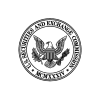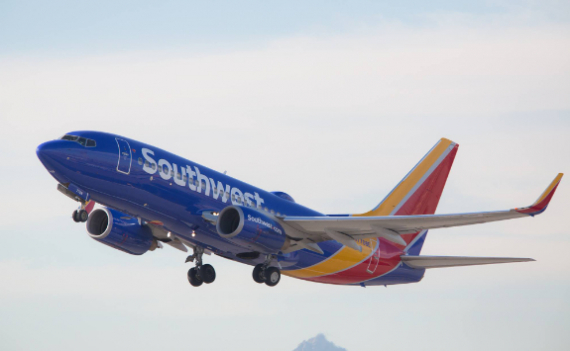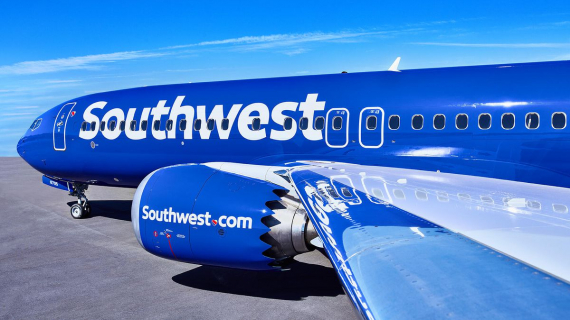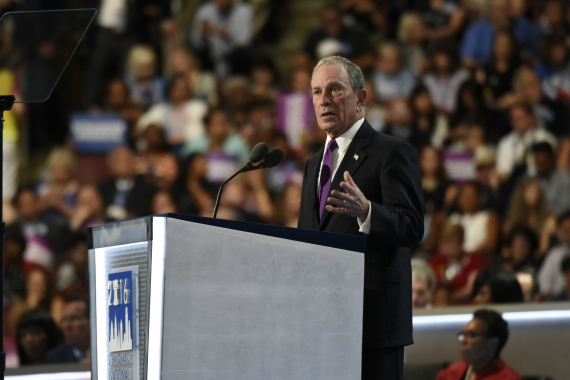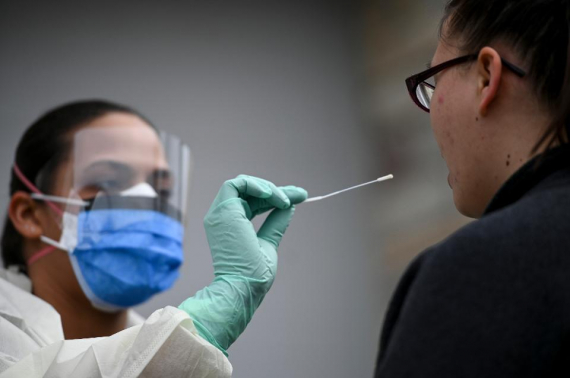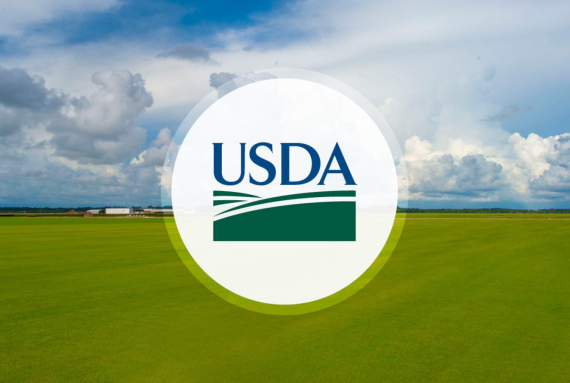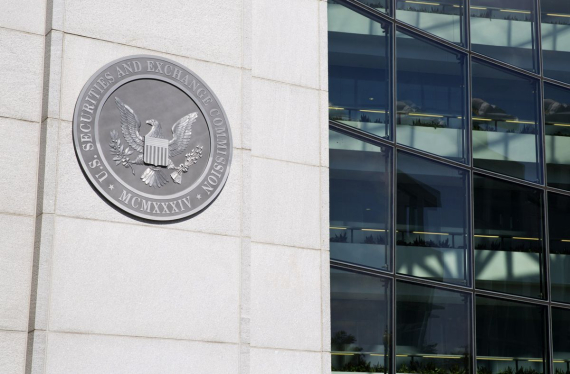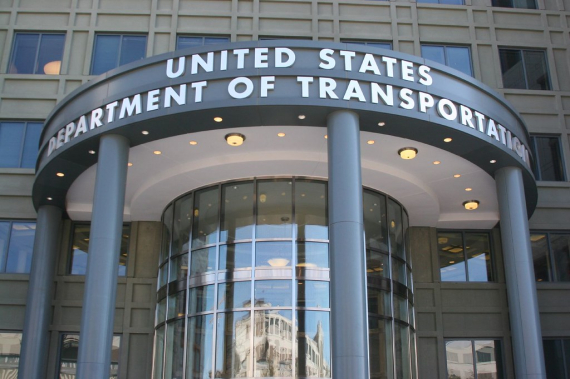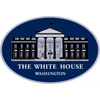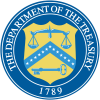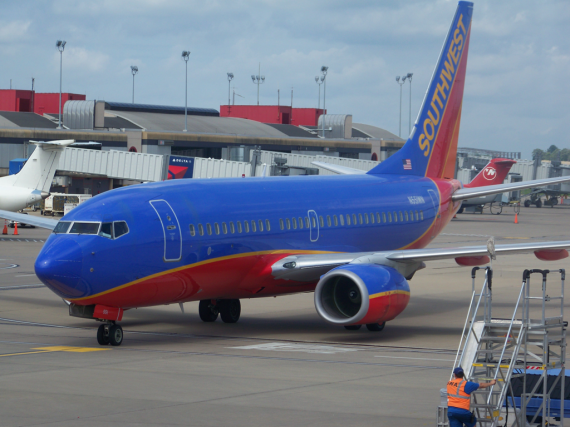
Southwest Airlines Co. (NYSE: LUV) (the "Company") today reported its fourth quarter and full year 2021 financial results:
- Fourth quarter net income of $68 million, or $0.11 per diluted share
- Excluding special items1, fourth quarter net income of $85 million, or $0.14 per diluted share
- Full year net income of $977 million, or $1.61 per diluted share, driven by a $2.7 billion offset of salaries, wages, and benefits expenses related to the receipt of
- Payroll Support Program (PSP) proceeds under the Consolidated Appropriations Act, 2021 and the American Rescue Plan Act of 2021
- Excluding special items, full year net loss of $1.3 billion, or $2.15 loss per diluted share
- Ended 2021 with liquidity2 of $16.5 billion, well in excess of debt outstanding of $10.7 billion
Gary C. Kelly, Chairman of the Board and Chief Executive Officer, stated, "We ended 2021 on a high note with our first quarterly profit, excluding special items, since fourth quarter 2019 before the COVID-19 pandemic began. Leisure travel demand was strong, particularly during the holidays, and business revenues continued to recover compared with 2019 levels. We also generated incremental revenue from our new co-brand credit card agreement secured in December 2021 with Chase Bank USA, N.A. Our fourth quarter 2021 cost performance was in line with expectations, which included hiring thousands of new Employees. While we continue to manage through an incredibly challenging operating environment, we made much progress in our recovery in 2021 and are well-positioned for future growth with our industry-leading balance sheet.
"We celebrated our 50th anniversary in 2021, opened 14 new airports, returned the Boeing 737 MAX (MAX) back into service, completed our launch of industry-standard corporate bookings through multiple Global Distribution System (GDS) platforms, and implemented a new maintenance record-keeping system—to name just a few major accomplishments despite the pandemic. Our Employees' resilience, teamwork, and care for Customers and one another has been a marvel to watch. Southwest was, once again, named to FORTUNE's 2021 list of the World's Most Admired Companies—a testament to our People—and I am pleased we were able to accrue $230 million of profitsharing in 2021 for their benefit.
"On February 1st, Bob Jordan will become the 6th CEO of Southwest. Since our announcement last June, Bob has been hard at work on the transition and is well-prepared to take on this important role. I have the utmost confidence in Bob, our Leadership Team, and the People of Southwest to lead the Company forward and execute a solid strategy. I am supremely honored and privileged to have served Southwest as CEO for 18 years, and I look forward to continuing to be a part of the Team as Executive Chairman."
Bob Jordan, Executive Vice President and Incoming Chief Executive Officer, stated, "Despite our fourth quarter profit, we had a challenging start to 2022 as we continue to recover from the pandemic. While we made significant progress in 2021, the Omicron variant has delayed the demand improvement we were previously expecting in early 2022. With COVID-19 cases trending downward, the worst appears to be behind us, and we are optimistic about current bookings and revenue trends for March 2022.
"We are experiencing higher unit cost inflation in 2022 as we continue to navigate the pandemic. The Omicron variant significantly impacted our available staffing beginning in early January 2022, and we temporarily extended incentive pay for Operations Employees through early February 2022, as we strive to maintain sufficient available staffing and minimize flight cancellations. Over the last two weeks we have returned to solid operational performance like we experienced over the holidays in fourth quarter 2021. We met our 2021 hiring goals, and we are planning to add at least 8,000 Employees this year. We are making additional investments to attract and retain talent, including our recent decision to further raise our starting hourly pay rates from $15 per hour to $17 per hour. We are currently in discussions with our workgroups to enact this increase in pay rates. Additionally, we are further moderating our first half 2022 capacity plans to provide additional buffer to the operation. Based on current plans, first quarter 2022 operating expenses per available seat mile (CASM, or unit costs), excluding fuel and oil expense, special items, and profitsharing, is expected to represent a peak, and our plans call for unit costs to ease from there into 2023.
"With the Omicron variant and weather impacting our results, we expect losses in January and February and a return to profitability in March 2022. Based on our current plan, while we no longer expect to be profitable in first quarter, we expect to be profitable for the remaining three quarters of this year, and for full year 2022. As demand for air travel recovers, we intend to substantially grow available seat miles (ASMs, or capacity) to restore the majority of our route network by the end of 2023. We remain laser focused on addressing staffing and cost challenges, and we are working urgently to return to historic productivity levels by the end of 2023, which, combined with planned ASM growth, we believe should enable a decrease in full year 2023 CASM, excluding fuel and oil expense, special items, and profitsharing, compared with full year 2022.
"Looking ahead, I am optimistic about our future. We have a solid strategy and intend to reinforce and build upon the core strengths of Southwest with several initiatives that we expect to create value and deliver significant financial benefits. In addition, we have made great progress in the areas of diversity, equity, and inclusion, as well as environmental sustainability, and we remain steadfast in our focus on these important areas with tangible goals. We have the best Employees and Leadership Team in the industry. I add my thanks and appreciation to our People for persevering when times are difficult and for never giving up on each other or Southwest. I am honored to serve them, our Customers, and our Shareholders, and I appreciate the support of Gary and the Board of Directors as I begin my new role as CEO."
Notable 2021 announcements and accomplishments include:
- Launched service to 14 airports: Chicago O'Hare International Airport; Sarasota Bradenton International Airport; Colorado Springs Municipal Airport; Savannah/Hilton Head International Airport; Houston's George Bush Intercontinental Airport; Santa Barbara Airport; Fresno Yosemite International Airport; Destin-Fort Walton Beach Airport; Myrtle Beach International Airport; Bozeman Yellowstone International Airport; Jackson-Medgar Wiley Evers International Airport in Mississippi; Eugene Airport in Oregon; Bellingham International Airport in Washington; and Syracuse Hancock International Airport
- Launched full-participation in Sabre's GDS platform on July 26, 2021, achieving the Company's goal of enabling industry-standard corporate bookings through multiple GDS platforms, also including Amadeus and Travelport's multiple platforms (Apollo, Worldspan, and Galileo)
- Received numerous awards and recognitions, including:
- Named to FORTUNE's list of World's Most Admired Companies for 2021; ranked #14
- Named among the highest ranking carriers for customer satisfaction in the J.D. Power 2021 North American Satisfaction StudySM; ranked #2
- Named the top domestic airline for customer service by the 2021 Elliot Readers' Choice Customer Service Awards
- Named a Top 100 Company by BetterInvesting Magazine
- Named to Glassdoor's Best Places to Work list for the 12th consecutive year
- Named a Best Employer for Women 2021 by Forbes
- Named as one of MilitaryTimes Best for Vets: Employers 2021
- Named a Best Place to Work for Disability Inclusion after achieving a top score on Disability:IN's 2021 Disability Equality Index
- Named as A Best Place to Work for LGBTQ Equality in 2021 from the Human Rights Campaign Foundation
- Named one of America's Most Trusted Travel & Hospitality Brands by Morning Consult; ranked #3
- Named Domestic Carrier of the Year by the Airforwarders Association for the 12th consecutive year
- Ranked #1 for Most Reliable Airline and #4 for Best Airline by WalletHub
- Environmental, Social, and Governance (ESG):
- Announced long-term goal to be carbon neutral by 2050
- Established a plan of action to reduce Southwest's carbon emissions intensity by at least 20 percent by 2030 and maintain carbon neutral growth every year through the end of the decade
- Announced multiple offtake agreements and memoranda of understanding with sustainable aviation fuel producers
- Partnered with Chooose™ and Customers to offset Southwest's carbon emissions by providing the first U.S.-based airline carbon offset offer with loyalty points and for every dollar contributed toward offsetting Southwest's carbon emissions, Southwest will match the contribution3
- Committed $10 million to Yale University's Center for Natural Carbon Capture to research technological advancements and find new solutions to reduce net greenhouse gas emissions
- Joined the Aviation Climate Taskforce, a new nonprofit founded with a goal to tackle the challenges of reducing carbon emissions in aviation
- Published a Human Rights Policy which formalizes Southwest's longstanding support of human rights principles
- Outlined the next steps in Southwest's Continued Commitment to increase racial and gender diversity in Southwest Leadership
- Assisted with humanitarian efforts to relocate Afghanistan refugees, operating 93 domestic charter flights carrying more than 11,000 People across the United States
- Awarded $110,000 to students through the Southwest Airlines® Scholarship Program, continuing Southwest's focus on providing more equitable education opportunities to college-bound students while promoting diverse academic pathways, and ultimately inspiring future generations to pursue careers within the airline industry
- Expanded citizenship reporting in the Southwest Airlines One Report by aligning with the Sustainability Accounting Standards Board (SASB) and United Nations Sustainable Development Goals (UNSDG) reporting frameworks, in addition to the Global Reporting Initiatives (GRI) Standards
Revenue Results and Outlook
The Company's fourth quarter 2021 operating revenues increased 150.9 percent, year-over-year, to $5.1 billion, but decreased 11.8 percent compared with fourth quarter 2019 due to the impact of the pandemic. Fourth quarter 2021 operating revenues per available seat mile (RASM, or unit revenues) was 13.77 cents, a decrease of 3.8 percent, driven primarily by a passenger revenue yield decrease of 4.1 percent and a load factor decrease of 2.1 points, compared with fourth quarter 2019.
The Company's October 2021 operating revenues included a negative impact of approximately $75 million as a result of flight cancellations from operational challenges and related Customer refunds and gestures of goodwill. This negative impact to October 2021 operating revenues was substantially offset by an improvement in bookings and revenue trends compared with August and September 2021, which was the time period most negatively impacted by the Delta variant. The Company ended the year with a solid revenue performance driven primarily by strong leisure demand and fares during the November and December 2021 holiday period, as well as incremental revenue generated from the Company's new co-brand credit card agreement secured in December 2021 with Chase Bank USA, N.A. Fourth quarter 2021 represented the Company's best quarterly revenue performance since the pandemic began, with operating revenues performing in line with the Company's most recent expectations. The lingering effects from the Delta variant resulted in a fourth quarter 2021 negative operating revenue impact of approximately $60 million, and the initial impact attributable to the Omicron variant resulted in a negative operating revenue impact of approximately $30 million. Combined, this $90 million negative operating revenue impact was slightly less than the Company's previous estimate of $100 million related to COVID-19 waves in fourth quarter 2021. December 2021 managed business revenues declined 50 percent compared with December 2019, outperforming the Company's previous expectation of down 55 percent to 60 percent versus December 2019 levels, driven by increased passengers and stronger fares.
Following strong travel demand during the holiday period, the Company is experiencing a revenue headwind in first quarter 2022 due to a softness in bookings and an increase in trip cancellations associated with the Omicron variant. January and February are seasonally weaker time periods for leisure travel demand, but further softness in leisure bookings related to the Omicron variant, combined with lower than expected business travel demand, is estimated to reduce operating revenues in January and February 2022 by $330 million, combined. The Company has canceled more than 5,600 flights, thus far, in January 2022, with the majority attributable to available staffing challenges as a result of the Omicron variant, as well as weather-related cancellations, driving an estimated $50 million negative impact to January 2022 operating revenues. First quarter 2022 managed business revenues are expected to be down 45 percent to 55 percent versus first quarter 2019 levels. The Company remains optimistic about the return of business travel demand in 2022 based on the momentum experienced in fourth quarter 2021 before the impact of the Omicron variant. The Company is also encouraged by recent improvements in booking trends, especially for March 2022, and current revenue trends for spring break travel appear to be in line with typical seasonal expectations.
Full year 2021 total operating revenues increased 74.5 percent, year-over-year, to $15.8 billion, but decreased 29.6 percent compared with 2019 due to the impact of the pandemic. Full year 2021 RASM was 11.96 cents, a decrease of 16.1 percent, primarily due to a passenger revenue yield decrease of 14.2 percent and a load factor decrease of 5.0 points, compared with 2019.
Cost Performance and Outlook
Fourth quarter 2021 operating expenses increased 52.6 percent, year-over-year, to $4.9 billion, but decreased 4.1 percent compared with fourth quarter 2019. Excluding special items, fourth quarter 2021 operating expenses increased 51.1 percent, year-over-year, to $4.8 billion, but decreased 4.4 percent compared with fourth quarter 2019. Fourth quarter 2021 CASM increased 4.6 percent, compared with fourth quarter 2019. Excluding special items, fourth quarter 2021 CASM increased 4.3 percent, compared with fourth quarter 2019.
As of January 20, 2022, the fair market value of the Company's fuel derivative contracts settling in first quarter 2022 was an asset of approximately $155 million and an asset of approximately $450 million for those settling over the remainder of 2022. In addition, the fair market value of fuel derivative contracts settling in 2023 and beyond was an asset of approximately $403 million. Additional information regarding the Company's fuel derivative contracts is included in the accompanying tables.
The Company's fourth quarter 2021 fuel efficiency declined 4.2 percent, year-over-year, due to the removal from storage and return to service of more of the Company's least fuel-efficient aircraft, the Boeing 737-700 (-700), to support sequentially increasing flight schedules. When compared with fourth quarter 2019, fuel efficiency improved 3.8 percent in fourth quarter 2021 due to the March 2021 return to service of the Company's most fuel-efficient aircraft, the MAX. The MAX remains critical to the Company's efforts to modernize its fleet, reduce carbon emissions intensity, and achieve its near-term environmental sustainability goals.
Excluding fuel and oil expense, fourth quarter 2021 operating expenses increased 34.1 percent year-over-year, and decreased 3.8 percent, compared with fourth quarter 2019. The Company accrued $43 million of profitsharing expense in fourth quarter 2021, for a total of $230 million in 2021, compared with no profitsharing in 2020. Excluding fuel and oil expense, special items, and profitsharing, fourth quarter 2021 operating expenses increased 32.0 percent, year-over-year, and increased 1.5 percent compared with fourth quarter 2019. Fourth quarter 2021 CASM, excluding fuel and oil expense, special items, and profitsharing, decreased 14.5 percent, year-over-year, driven primarily by an increase in capacity, and increased 10.6 percent compared with fourth quarter 2019, which was in line with the Company's expectation. The primary drivers of the 10.6 percent unit cost increase, compared with fourth quarter 2019, were investments in the operation to bolster staffing, vaccination incentive pay, inflation in labor rates and airport costs, and other cost inflation related to lower productivity levels.
Based on current cost trends and recently reduced capacity plans, first quarter 2022 operating expenses, excluding fuel and oil expense, special items, and profitsharing, are expected to increase in the range of 20 percent to 24 percent on a unit basis5 as compared with first quarter 2019, an increase from the Company's previous guidance of 10 percent to 14 percent. The Company continues to experience cost pressure due to inflation in labor rates and airport costs, as well as unit cost headwinds from operating at suboptimal productivity levels. Additionally, the Company has temporarily extended incentive pay to its Operations Employees through early February 2022, which is expected to result in an additional $150 million of salaries, wages, and benefits expense in first quarter 2022. Furthermore, the Company is reducing its first quarter 2022 capacity to provide additional stability during this challenging environment. Compared with the Company's previous first quarter 2022 unit cost guidance, excluding fuel and oil expense, special items, and profitsharing, approximately half of the estimated unit cost increase is attributable to the temporary incentive pay offered to Operations Employees, and the remaining half is driven by reduced capacity.
The Company now expects its first quarter and full year 2022 interest expense to be $90 million and $360 million, respectively, a decrease from its previous expectation of $110 million and $440 million, respectively, due to the Company's adoption of a new accounting standard related to convertible debt. Effective January 1, 2022, the Company adopted Accounting Standards Update (ASU) No. 2020-06, Debt—Debt with Conversion and Other Options (Subtopic 470-20) and Derivatives and Hedging—Contracts in Entity's Own Equity (Subtopic 815-40): Accounting for Convertible Instruments and Contracts in an Entity's Own Equity. As a result of this new standard, the Company will no longer record amortization of the debt discount associated with its convertible notes to interest expense.
Full year 2021 operating expenses increased 9.4 percent to $14.1 billion, and decreased 14.2 percent on a unit basis, both year-over-year. Compared with 2019, full year 2021 operating expenses decreased 27.7 percent, and decreased 13.9 percent on a unit basis. Excluding fuel and oil expense, special items, and profitsharing, full year 2021 operating expenses increased 10.7 percent, and decreased 13.3 percent on a unit basis, both year-over-year. Compared with 2019, operating expenses, excluding fuel and oil expense, special items, and profitsharing, decreased 6.8 percent, and increased 11.1 percent on a unit basis. The Company realized approximately $1.1 billion of full year 2021 cost savings from voluntary separation and extended leave programs compared with full year 2019, and expects no material cost savings from these programs in 2022 and beyond.
Fleet and Capacity
The Company ended 2021 with 728 Boeing 737 aircraft, including 69 Boeing 737-8 (-8) aircraft. During 2021, the Company retired eight owned -700 aircraft, which were accelerated from 2022 into fourth quarter 2021, and returned 10 leased -700 aircraft, of which one occurred during fourth quarter 2021. In addition, the Company took delivery of 28 -8 aircraft during 2021. As of December 31, 2021, six -700 aircraft remained in temporary storage due to fourth quarter 2021 and first quarter 2022 capacity remaining below respective 2019 levels.
During fourth quarter 2021, the Company exercised 22 -7 options for delivery in 2023, and on January 1, 2022, the Company exercised another 12 Boeing options—five -8 options for delivery in 2022 and seven -7 options for delivery in 2023. Including the options exercised on January 1, 2022, the Company's order book with Boeing contains 406 MAX firm orders (271 -7 and 135 -8) and 226 MAX options (-7 or -8) for years 2022 through 2031. The Company continues to expect that more than half of the MAX aircraft in its firm order book will replace a significant amount of its 452 -700 aircraft over the next 10 to 15 years to support the modernization of its fleet, a key cost initiative and component of its environmental sustainability efforts. Additional information regarding the Company's aircraft delivery schedule is included in the accompanying tables.
The Company's fourth quarter 2021 capacity increased 54.4 percent, year-over-year, but decreased 8.3 percent compared with fourth quarter 2019. Full year 2021 capacity increased 27.6 percent, year-over-year, but decreased 16.1 percent compared with full year 2019. While the Company's flight schedule is published for sale through September 5, 2022, the Company is in the process of adjusting its published flight schedules for March through May 2022 in light of recent staffing challenges due to the Omicron variant. The Company will continue to monitor staffing trends, along with booking and cancellation trends, and adjust capacity, as needed. As such, the Company's actual flown capacity may differ from currently published flight schedules or current guidance.
Liquidity and Capital Deployment
As of December 31, 2021, the Company had approximately $15.5 billion in cash and short-term investments and a fully available revolving credit line of $1.0 billion. The Company continues to have unencumbered assets with an estimated value of more than $11.0 billion, including aircraft value estimated in the range of $9.0 billion to $9.5 billion, and approximately $2.0 billion in non-aircraft assets such as spare engines, ground equipment, and real estate. In addition, the Company has significant value from its Rapid Rewards® loyalty program. As of January 25, 2022, the Company had cash and short-term investments of approximately $15.3 billion.
Full year 2021 cash provided by operations was $2.3 billion, driven primarily by PSP proceeds of $2.7 billion. Full year 2021 capital expenditures were $505 million, in line with the Company's expectations, driven primarily by technology, facilities, and operational investments, as well as aircraft-related capital expenditures. The Company continues to estimate its 2022 capital spending to be approximately $5.0 billion, including approximately $900 million in non-aircraft capital spending. This includes five 2022 -8 options exercised on January 1, 2022, and assumes the Company exercises all 37 remaining 2022 options6. Fleet and other capital investment plans are expected to evolve as the Company continues to manage through the pandemic, and the Company intends to continue evaluating the exercise of its remaining 37 MAX options for 2022 as decision deadlines occur.
As of December 31, 2021, the Company had current and non-current debt obligations that totaled $10.7 billion. The Company repaid approximately $607 million in debt and finance lease obligations during fourth quarter 2021, including the prepayment of $392 million in aircraft secured term loans and the extinguishment of $124 million in principal of its convertible notes for a cash payment of $172 million. As of December 31, 2021, the Company was in a net cash position7 of $4.8 billion, and its adjusted debt8 to invested capital (leverage) was 54 percent.
Conference Call
The Company will discuss its fourth quarter and full year 2021 results on a conference call at 12:30 p.m. Eastern Time today. To listen to a live broadcast of the conference call please go to www.southwestairlinesinvestorrelations.com.
1See Note Regarding Use of Non-GAAP Financial Measures for additional information on special items. In addition, information regarding special items and economic results is included in the accompanying table Reconciliation of Reported Amounts to Non-GAAP Items (also referred to as "excluding special items").
2Includes approximately $15.5 billion in cash and short-term investments and a fully available revolving credit line of $1.0 billion.
3Taxes and fees will not be matched by Southwest or earn points. Southwest's contribution may be used to purchase offsets for Southwest from any carbon offset project of Southwest's choice. Rapid Rewards® Members can earn 10 Rapid Rewards bonus points per dollar contributed towards the purchase of offsets for Southwest up to a maximum of 500 Rapid Rewards bonus points per month. Points will only be awarded to the Rapid Rewards Member's Rapid Rewards account number entered at the time of the carbon offset transaction. Terms and conditions apply.
4Based on the Company's existing fuel derivative contracts and market prices as of January 20, 2022, both first quarter and full year 2022 economic fuel costs per gallon are estimated to be in the range of $2.25 to $2.35. Economic fuel cost projections do not reflect the potential impact of special items because the Company cannot reliably predict or estimate the hedge accounting impact associated with the volatility of the energy markets, the impact of COVID-19 cases on air travel demand, or the impact to its financial statements in future periods. Accordingly, the Company believes a reconciliation of non-GAAP financial measures to the equivalent GAAP financial measures for projected results is not meaningful or available without unreasonable effort. See Note Regarding Use of Non-GAAP Financial Measures.
5Projections do not reflect the potential impact of fuel and oil expense, special items, and profitsharing because the Company cannot reliably predict or estimate those items or expenses or their impact to its financial statements in future periods, especially considering the significant volatility of the fuel and oil expense line item. Accordingly, the Company believes a reconciliation of non-GAAP financial measures to the equivalent GAAP financial measures for these projected results is not meaningful or available without unreasonable effort.
6Excluding any further exercises in 2022, the Company's 2022 capital expenditures would be approximately $3.0 billion, also including approximately $900 million in non-aircraft capital spending.
7Net cash position is calculated as the sum of cash and cash equivalents and short-term investments, less the sum of short-term and long-term debt.
8Adjusted debt is calculated as short-term and long-term debt including the net present value of aircraft rentals related to operating leases.
Cautionary Statement Regarding Forward-Looking Statements
This news release contains forward-looking statements within the meaning of Section 27A of the Securities Act of 1933, as amended, and Section 21E of the Securities Exchange Act of 1934, as amended. Specific forward-looking statements include, without limitation, statements related to (i) the Company's growth plans and opportunities; (ii) the Company's expectations with respect to its progress in 2022 towards pandemic recovery and the future impacts of the pandemic; (iii) the Company's expectations with respect to investments in the Company's operations and People, including the Company's hiring plans and associated goals with respect to operational efficiency, stability, and reliability; (iv) the Company's plans and expectations with respect to capacity and capacity adjustments, including factors and assumptions underlying the Company's expectations and projections; (v) the Company's financial and operational outlook, goals, plans, expectations, and projected results of operations, including factors and assumptions underlying the Company's expectations and projections; (vi) the Company's network plans and expectations; (vii) the Company's initiatives and related expectations regarding value creation and financial benefits; (viii) the Company's plans and expectations with respect to load factor; (ix) the Company's expectations with respect to its emissions goals, fuel costs, fuel efficiency, hedging gains, and the Company's related management of risks associated with changing jet fuel prices, including factors underlying the Company's expectations; (x) the Company's plans, estimates, and assumptions related to repayment of debt obligations, interest expense, effective tax rate, and capital spending, including factors and assumptions underlying the Company's expectations and projections; (xi) the Company's plans and expectations regarding its fleet and fleet delivery schedule, including factors and assumptions underlying the Company's plans and expectations; and (xii) the Company's expectations regarding passenger demand, revenue trends, and bookings, including with respect to managed business revenues. These forward-looking statements are based on the Company's current estimates, intentions, beliefs, expectations, goals, strategies, and projections for the future and are not guarantees of future performance. Forward-looking statements involve risks, uncertainties, assumptions, and other factors that are difficult to predict and that could cause actual results to vary materially from those expressed in or indicated by them. Factors include, among others, (i) any negative developments related to the COVID-19 pandemic, including, for example, with respect to the duration, spread, severity, or any recurrence of the COVID-19 pandemic or any new variant strains of the underlying virus; the effectiveness, availability, and usage of COVID-19 vaccines; the impact of government mandates, directives, orders, regulations, and other governmental actions related to COVID-19 on the Company's business plans and its ability to retain key Employees; the extent of the impact of COVID-19 on overall demand for air travel and the Company's related business plans and decisions; and the impact of the COVID-19 pandemic on the Company's access to capital; (ii) the Company's dependence on its workforce, including its ability to employ sufficient numbers of qualified Employees to effectively and efficiently maintain its operations; (iii) the impact of labor matters on the Company's business decisions, plans, and strategies; (iv) the impact of fears or actual outbreaks of other diseases, extreme or severe weather and natural disasters, actions of competitors (including, without limitation, pricing, scheduling, capacity, and network decisions, and consolidation and alliance activities), consumer perception, economic conditions, fears of terrorism or war, socio-demographic trends, and other factors beyond the Company's control, on consumer behavior and the Company's results of operations and business decisions, plans, strategies, and results; (v) the impact of fuel price changes, fuel price volatility, volatility of commodities used by the Company for hedging jet fuel, and any changes to the Company's fuel hedging strategies and positions, on the Company's business plans and results of operations; (vi) the Company's dependence on Boeing with respect to the Company's fleet plans, operations, strategies, and goals; (vii) the impact of governmental regulations and other governmental actions on the Company's business plans and operations; (viii) the Company's dependence on other third parties, in particular with respect to its fuel supply and environmental sustainability initiatives, and the impact on the Company's operations and results of operations of any third party delays or non-performance; (ix) the Company's ability to timely and effectively implement, transition, and maintain the necessary information technology systems and infrastructure to support its operations and initiatives; (x) the Company's dependence on Boeing and the Federal Aviation Administration with respect to the certification of the Boeing MAX 7 aircraft; and (xi) other factors, as described in the Company's filings with the Securities and Exchange Commission, including the detailed factors discussed under the heading "Risk Factors" in the Company's Annual Report on Form 10-K for the fiscal year ended December 31, 2020, and its Quarterly Report on Form 10-Q for the quarter ended September 30, 2021.















